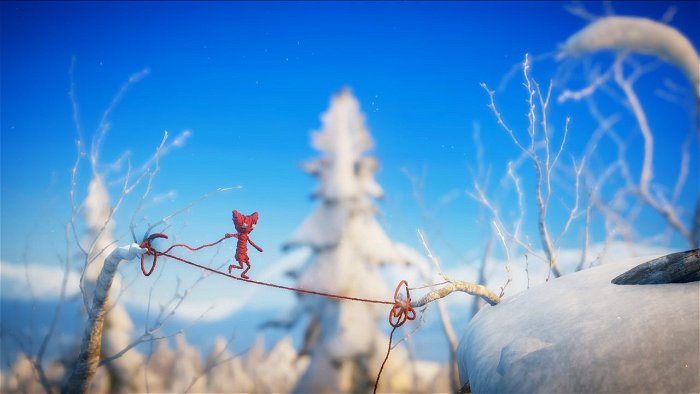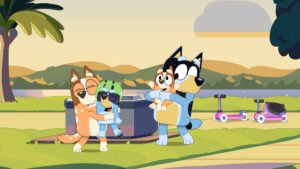It’s one thing to be a successful game developer; it’s another thing to be successful and truly passionate about your work. For an already established studio to transition from a familiar formula and completely redesign their philosophy requires a huge, risky leap of faith. Coldwood Interactive took that risk with their new puzzle platformer, Unravel. Judging from the massively positive response they have already received, this decision could just pay off. EA clearly seems to think so, as they proudly chose to publish this exciting new project.
Coldwood Interactive is a studio based out of Northern Sweden. Since 2003, they have produced a number of small sports titles through several publishers including Sony Computer Entertainment Europe. According to Jakob Marklund, Technical Director of Coldwood, “You’ve probably never even heard of any of these games, but I can assure you they are out there somewhere.” At the end of the last of one of these projects, the team decided it was time to sit down and really think about their philosophy as a studio, and really explore what kinds of games they wish to make. It was then that they decided to delve into the idea that a game can be more than just entertainment; it could enrich the lives of those who play it.

It was Martin Sahlin, Creative Director at Coldwood, who came up with the concept for Unravel. He described a game where yarn could be used as a metaphor that represents the bond between people, specifically an elderly woman and memories of people from her past. This fascinated the CEO, and he immediately asked Martin to develop some pitch material. Martin however, was away on a camping trip with his family. Martin scrounged for materials; he borrowed some wool from a nearby camper, and the result is the adorable yarn hero of Unravel. As he began taking photographs, he explored gameplay ideas — Yarny would create lassos to climb and swing from, bridges to cross and trampoline off of, and explore the beautifully designed Scandinavian countryside.
CGM had an opportunity to speak with Martin and discuss Coldwood’s new direction, as well as find out more about Unravel.
CGM: Coldwood has made some very straightforward games in the past, such as Move Fitness and Skiracing. Unravel seems like a big divergence from these type of games. What made your team come to the decision to create a game that’s more based on metaphor?
Martin Sahlin: I think the root of that decision came out of a need. It was something that I needed to do. We made a fighting game with Sony quite a while back, which wasn’t very good. No, it had some great parts in it, and people have bought it and loved it. But the critics really hated it, for good reasons too. And yet it still reached about 700,000 people. 700,000 people who felt very strongly about it, because we have very vocal fans. They loved it and said the critics were wrong.
That’s not important. What’s important is that there were so many people caring about something that was considered a failure. Imagine how it would be if that many people cared about something that was any good. It felt like, with an audience like that, it’s almost irresponsible to make a game that was about nothing. So I felt like I needed to make a game that had something to say. And, I mean, it’s not like we’re trying to change the world by making a game with strong themes about love. It’s more like, if they’re going to spend all that precious time and attention on something, they should at least be enriched by it. Maybe inspired to think. Or maybe even something as simple as making them feel good.

CGM: You mentioned that one of the deeper themes of the storyline is love. Can you tell me a little about the story in Unravel and maybe how it demonstrates that theme?
MS: Thing is, I don’t want to say too much about the story of the game, because it’s one of those things I want players to discover for themselves. I’m a big fan of environmental storytelling, or using characters to tell a story, or through the music, and things that you actually do, rather than doing the traditional cutscene thing. I also want to leave it very open to interpretation. That’s why I’m so reluctant to say anything about the story itself, because then people will just be seeing what I’m seeing and I want them to see what they want to see.
As you play, it is obvious that certain themes are there: themes about love, and about longing, and about reaching out. I mean the whole thing about tying this red thread through the game, from the start to the finish is obviously very symbolic. But I think that it’s very important that we let the players come to the story, rather than bringing the story to the players because I guess it’s the kind of subject matter that could end up becoming very sentimental if we make it too forced.
CGM: So was the use of a hyper-realistic style a way for the team to develop these themes?
MS: It was one of those things where the whole game design and art direction just happened on its own. Like as I was playing with the doll, I realised like, this is the perfect way to do it; to bring your perspective down to ground level, so to speak, so that you can really look closely at stuff, and appreciate just how beautiful it is. It sounds very “hippie” to say, but it’s so…the environments themselves are not super out-there. They’re not fantastical. They’re not extreme. They’re just like, it’s our own backyard! If we took environments from our home and just put that in there, it means something to us; it makes us feel things. And we want to show off how beautiful it is, not by exaggerating, but by bringing you really close to it, so that you can appreciate it. Simple things like flowers, mushrooms, whatever, you get a chance to really look at them.
CGM: It’s got a very nostalgic feel. It feels very personal.
MS: It is. We tried on purpose to choose environments that have a deeper meaning to us. It’s not all about showing off the most beautiful stuff. It’s about the places that have some kind of memory connected to them, or a special meaning.
CGM: What’s your favourite part of the game?
MS: The thing I enjoy the most is when you get that…kind of that flow going. This fluid motion where you link lasso swings together. I have a favorite place—I think it’s like on the fifth level or something like that—where you land on this platform and you anchor the rope there; you tie it in place, and you can jump off the platform and you can grab your tail end in mid-air, kind of break your momentum and swing the other way, so that you’re swinging underneath the platform. And you can use your lasso to grab another anchor and just keep swinging like that, so you get this flow of motion going. It just feels so very, very good. I think that, because you move so much left to right in games like this, we wanted moving left to right to feel really satisfying. Even if nothing else is going on, the simple act of getting from here to there should be fun.




